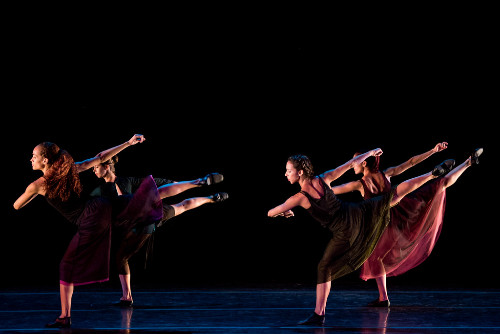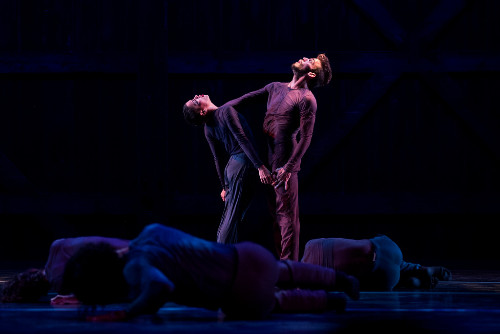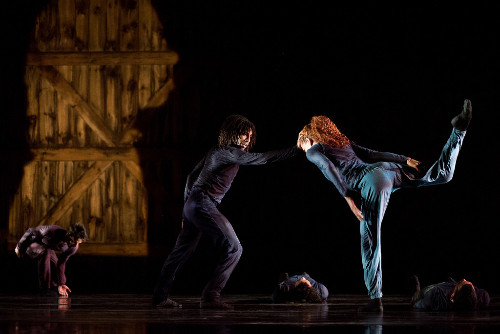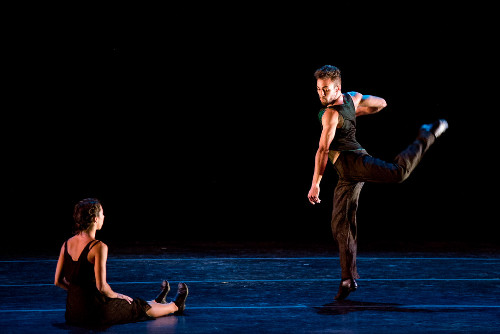Cuba's Malpaso Dance Company at Jacob's Pillow
With Arturo O’Farrill and the Afro Latin Jazz Ensemble
By: Charles Giuliano - Aug 10, 2015

Dunia Acosta Arias, Beatriz Garcia Diaz, Maria Karla Araujo, and Taimy Miranda Ruiz de Villa of Malpaso Dance Company in "Under Fire"; photo Cherylynn Tsushima
Dunia Acosta Arias of Malpaso Dance Company in "Under Fire"; photo by Morah Geist
Maria Karla Araujo and Joan Rodríguez Hernandez of Malpaso Dance Company in "Under Fire"; photo Cherylynn Tsushima
Malpaso Dance Company in "Under Fire"; photo by Cherylynn Tsushima
Dunia Acosta Arias, Beatriz Garcia Diaz, Maria Karla Araujo, and Taimy Miranda Ruiz de Villa of Malpaso Dance Company in "Under Fire"; photo Cherylynn Tsushima
Maria Karla Araujo and Osnel Delgado Wambrug of Malpaso Dance Company in "Under Fire"; photo Cherylynn Tsushima
Dunia Acosta Arias of Malpaso Dance Company in "Under Fire"; photo Cherylynn Tsushima
Malpaso Dance Company in "Under Fire"; photo Cherylynn Tsushima
Taimy Miranda Ruiz de Villa and Randy Cívico Rivas of Malpaso Dance Company of "Under Fire"; photo Cherylynn Tsushima
Randy Cívico Rivas and Osnel Delgado Wambrug of Malpaso Dance Company in "Under Fire"; photo Cherylynn Tsushima
Dunia Acosta Arias and Osnel Delgado Wambrug of Malpaso Dance Company in "Despedida"; photo Cherylynn Tsushima
Beatriz Garcia Diaz, Randy Cívico Rivas, and Osnel Delgado Wambrug of Malpaso Dance Company in "Despedida"; photo Cherylynn Tsushima
Daileidys Carranzana Gonzalez, Osnel Delgado Wambrug, and Joan Rodríguez Hernande of Malpaso Dance Company in "Despedida"; photo Cherylynn Tsushima
Rafi Malkiel of the Afro Latin Jazz Ensemble with Osnel Delgado Wambrug, Manuel Durán Calzado, and Beatriz Garcia Diaz of Malpaso Dance Company in "Despedida"; photo Cherylynn Tsushima
Daileidys Carranzana Gonzalez and Joan Rodríguez Hernandez of Malpaso Dance Company in "Despedida"; photo Cherylynn Tsushima
Joan Rodríguez Hernandez and Daileidys Carrazana Gonzalez of Malpaso Dance Company in "Despedida"; photo Cherylynn Tsushima
Randy Cívico Rivas and Beatriz Garcia Diaz of Malpaso Dance Comapny in "Despedida"; photo Cherylynn Tsushima
Osnel Delgado Wambrug and Dunia Acosta Arias of Malpaso Dance Company in "Despedida"; photo Cherylynn Tsushima
Osnel Delgado Wambrug and Dunia Acosta Arias of Malpaso Dance Company in "Despedida"; photo Cherylynn Tsushima
Osnel Delgado of Malpaso Dance Company in "Despedida"; photo Cherylynn Tsushima
Dailedys Carrazana Gonzalez and Joan Rodriguez Hernandez of Malpaso Dance Company in "Despedida"; photo Morah Geist
Dailedys Carrazana Gonzalez and Joan Rodríguez Hernandez of Malpaso Dance Company in "Despedida"; photo Morah Geist

Malpaso Dance Company in "Under Fire"; photo by Cherylynn Tsushima

Beatriz Garcia Diaz, Randy Cívico Rivas, and Osnel Delgado Wambrug of Malpaso Dance Company in "Despedida"; photo Cherylynn Tsushima

Daileidys Carranzana Gonzalez and Joan Rodríguez Hernandez of Malpaso Dance Company in "Despedida"; photo Cherylynn Tsushima
Dunia Acosta Arias of Malpaso Dance Company in "Under Fire"; photo by Morah Geist
Maria Karla Araujo and Joan Rodríguez Hernandez of Malpaso Dance Company in "Under Fire"; photo Cherylynn Tsushima
Malpaso Dance Company in "Under Fire"; photo by Cherylynn Tsushima
Dunia Acosta Arias, Beatriz Garcia Diaz, Maria Karla Araujo, and Taimy Miranda Ruiz de Villa of Malpaso Dance Company in "Under Fire"; photo Cherylynn Tsushima
Maria Karla Araujo and Osnel Delgado Wambrug of Malpaso Dance Company in "Under Fire"; photo Cherylynn Tsushima
Dunia Acosta Arias of Malpaso Dance Company in "Under Fire"; photo Cherylynn Tsushima
Malpaso Dance Company in "Under Fire"; photo Cherylynn Tsushima
Taimy Miranda Ruiz de Villa and Randy Cívico Rivas of Malpaso Dance Company of "Under Fire"; photo Cherylynn Tsushima
Randy Cívico Rivas and Osnel Delgado Wambrug of Malpaso Dance Company in "Under Fire"; photo Cherylynn Tsushima
Dunia Acosta Arias and Osnel Delgado Wambrug of Malpaso Dance Company in "Despedida"; photo Cherylynn Tsushima
Beatriz Garcia Diaz, Randy Cívico Rivas, and Osnel Delgado Wambrug of Malpaso Dance Company in "Despedida"; photo Cherylynn Tsushima
Daileidys Carranzana Gonzalez, Osnel Delgado Wambrug, and Joan Rodríguez Hernande of Malpaso Dance Company in "Despedida"; photo Cherylynn Tsushima
Rafi Malkiel of the Afro Latin Jazz Ensemble with Osnel Delgado Wambrug, Manuel Durán Calzado, and Beatriz Garcia Diaz of Malpaso Dance Company in "Despedida"; photo Cherylynn Tsushima
Daileidys Carranzana Gonzalez and Joan Rodríguez Hernandez of Malpaso Dance Company in "Despedida"; photo Cherylynn Tsushima
Joan Rodríguez Hernandez and Daileidys Carrazana Gonzalez of Malpaso Dance Company in "Despedida"; photo Cherylynn Tsushima
Randy Cívico Rivas and Beatriz Garcia Diaz of Malpaso Dance Comapny in "Despedida"; photo Cherylynn Tsushima
Osnel Delgado Wambrug and Dunia Acosta Arias of Malpaso Dance Company in "Despedida"; photo Cherylynn Tsushima
Osnel Delgado Wambrug and Dunia Acosta Arias of Malpaso Dance Company in "Despedida"; photo Cherylynn Tsushima
Osnel Delgado of Malpaso Dance Company in "Despedida"; photo Cherylynn Tsushima
Dailedys Carrazana Gonzalez and Joan Rodriguez Hernandez of Malpaso Dance Company in "Despedida"; photo Morah Geist
Dailedys Carrazana Gonzalez and Joan Rodríguez Hernandez of Malpaso Dance Company in "Despedida"; photo Morah Geist

Osnel Delgado Wambrug and Dunia Acosta Arias of Malpaso Dance Company in "Despedida"; photo Cherylynn Tsushima
Dunia Acosta Arias of Malpaso Dance Company in "Under Fire"; photo by Morah Geist
Maria Karla Araujo and Joan Rodríguez Hernandez of Malpaso Dance Company in "Under Fire"; photo Cherylynn Tsushima
Malpaso Dance Company in "Under Fire"; photo by Cherylynn Tsushima
Dunia Acosta Arias, Beatriz Garcia Diaz, Maria Karla Araujo, and Taimy Miranda Ruiz de Villa of Malpaso Dance Company in "Under Fire"; photo Cherylynn Tsushima
Maria Karla Araujo and Osnel Delgado Wambrug of Malpaso Dance Company in "Under Fire"; photo Cherylynn Tsushima
Dunia Acosta Arias of Malpaso Dance Company in "Under Fire"; photo Cherylynn Tsushima
Malpaso Dance Company in "Under Fire"; photo Cherylynn Tsushima
Taimy Miranda Ruiz de Villa and Randy Cívico Rivas of Malpaso Dance Company of "Under Fire"; photo Cherylynn Tsushima
Randy Cívico Rivas and Osnel Delgado Wambrug of Malpaso Dance Company in "Under Fire"; photo Cherylynn Tsushima
Dunia Acosta Arias and Osnel Delgado Wambrug of Malpaso Dance Company in "Despedida"; photo Cherylynn Tsushima
Beatriz Garcia Diaz, Randy Cívico Rivas, and Osnel Delgado Wambrug of Malpaso Dance Company in "Despedida"; photo Cherylynn Tsushima
Daileidys Carranzana Gonzalez, Osnel Delgado Wambrug, and Joan Rodríguez Hernande of Malpaso Dance Company in "Despedida"; photo Cherylynn Tsushima
Rafi Malkiel of the Afro Latin Jazz Ensemble with Osnel Delgado Wambrug, Manuel Durán Calzado, and Beatriz Garcia Diaz of Malpaso Dance Company in "Despedida"; photo Cherylynn Tsushima
Daileidys Carranzana Gonzalez and Joan Rodríguez Hernandez of Malpaso Dance Company in "Despedida"; photo Cherylynn Tsushima
Joan Rodríguez Hernandez and Daileidys Carrazana Gonzalez of Malpaso Dance Company in "Despedida"; photo Cherylynn Tsushima
Randy Cívico Rivas and Beatriz Garcia Diaz of Malpaso Dance Comapny in "Despedida"; photo Cherylynn Tsushima
Osnel Delgado Wambrug and Dunia Acosta Arias of Malpaso Dance Company in "Despedida"; photo Cherylynn Tsushima
Osnel Delgado Wambrug and Dunia Acosta Arias of Malpaso Dance Company in "Despedida"; photo Cherylynn Tsushima
Osnel Delgado of Malpaso Dance Company in "Despedida"; photo Cherylynn Tsushima
Dailedys Carrazana Gonzalez and Joan Rodriguez Hernandez of Malpaso Dance Company in "Despedida"; photo Morah Geist
Dailedys Carrazana Gonzalez and Joan Rodríguez Hernandez of Malpaso Dance Company in "Despedida"; photo Morah Geist

Maria Karla Araujo and Joan Rodríguez Hernandez of Malpaso Dance Company in "Under Fire"; photo Cherylynn Tsushima
Malpaso Dance Company
With Arturo O’Farrill and the Afro Latin Jazz Ensemble
Ted Shawn Theatre
Jacob’s Pillow Dance
August 5 to 9, 2015
Executive director and co-founder, Fernando Saez Carvajal
Artistic director and co-founder, Osnel Delgado Wamburg
Co-founder, Daileidys Carrazana Gonzalez
Dancers: Dunia Acosta Arias, Maria Karla Araujo, Isvel Bello Rodriguez, Daileidys Carrazana Gonzalez, Randy Civico Rivas, Osnel Delgado Wamburg, Manuel Duran Calzado, Beatriz Garcia Diaz, Taimy Mirando Ruiz de Villa, Joan Rodriguez Hernandez
Musicians: Vince Cherico, Carlo De Rosa, Carlos Maldonado, Rafi Malkiel, Adam O’Farrill, Arturo O’Farrill, Ivan Renta, Tony Rosa
Under Fire (2015)
Choreography, Trey McIntyre
Music, Grandma Kelsey
Lighting, Al Crawford
Costumes, Reid Bartelme
Despedida (2015)
Choreography, Osnel Delgado Wamburg ( In collaboration with the company)
Composer/ pianist, Arturo O’Farrill
Lighting, Al Crawford
Costume design, Reid Bartelme, Harriet Jung
Under departing artistic director, Ella Baff, Jacobs Pillow Dance, has brought global companies to the Berkshires. On her watch she has traveled widely to seek out emerging companies and provide the widest possible perspective on contemporary dance.
Now and then we have experienced the exotic ethnicity of companies exploring indigenous dance combined with classical training and contemporary innovations.
In seeing the Pillow debut of the Cuban based Malpaso Dance Company there was the anticipation of the Latin heat of Caribbean dance.
With Under Fire, the first of two pieces in the program, in a new work by Trey McIntyre set to music by the folk singer, Grandma Kelsey, there was a sense of sameness. It was not at all what one had expected.
Recently McIntyre, a familiar Pillow presence, has dissolved his company to focus on commissions such as this recent one. While the company as perfectly rendered an understated, moody, romantic work by McIntyre it provided scant insight to the current state of dance in Cuba.
With the recent easing of tension with the island nation this commission may well signify ever greater cross pollination of cultural resources. There is a sense among many Americans that it is important to see Cuba as soon as possible before its unique character and culture are homogenized. It was exactly what motivated me to travel to Berlin just months after the wall came down. Returning on occasions after that proved to be very different.
While this may be viewed as progress and change there is also loss of subtle and unique qualities.
If you are familiar with the McIntyre style this was a very clear and faithful exposition of its essentials. In program notes it is revealed that ridding himself of some paper work and baggage he burned a pile of documents. Poking through the embers he was surprised that some of the papers survived mostly intact. This became the metaphor that inspired the work. It is also a signifier of he personal artistic voyage of the choreographer having shed the responsibilities of maintaining a company.
The dance starts with a dense cluster. This separates with individuals departing to the wings. There are circular patterns with arms extended and at right angles slicing the air. It is a notable aspect of his style. Dancers merge and then dash off. They collide and bounce off.
The understated music of Kelsey, accompanying herself with guitar, proves to be a less than inspired match for the dance. In particular there was a disconnect as she sang the Dolly Parton standard "Jolene." One wondered about the synergy of such rural Americana as an inspiration for the Cuban company.
Perhaps they were making a statement about sophistication by evoking the mainstream of contemporary dance. But it proved to be a faltering decision for entering the international arena of major contemporary companies. It failed to provide a notion of what was unique and special about the company.
Our expectations of that insight were ratcheted up by the second work Despedida with choreography by Osnel Delgado Wamburg in collaboration with the company. It was set to music by Arturo O’Farrill leading an eight piece band set up in a corner in front of the stage.
There was mottled colored light by Al Crawford bathing the stage. Evoking creatures rising from the sea, an apt metaphor for the island culture, the dancers were spread out lying down. There was undulating movement as they gradually rose and this motif was duplicated to complete the dance. Again supine they rose and departed in airs from the outside leaving Wamburg alone in the center.
The music explored a suite of vignettes in a range of stylistic approaches. Initially there was dissonant jazz particularly in the phrasing of the brass and reeds. Typical of a Latin band in percussion there was a combination of hand drums and a jazz set. It was enjoyable when we heard a bit of salsa and a Latin beat.
The choreographer, Wamburg, was also the focus of the narrative. While the work showed the skill and versatility of the dancers it wasn’t particularly evocative or memorable.
Yet again it was rewarding to know what is emerging in global dance. This small exposure, however, was just the tip of the iceberg. One did not come away with deep insights about the state of contemporary dance in Cuba.
Based on this experience, however, one may conclude that Cuban culture is in a state of seismic transition. While it absorbs contemporary development, as emerges from decades of isolation and embargo, there will be the challenge of finding and affirming what is unique and valued about its complex culture.






